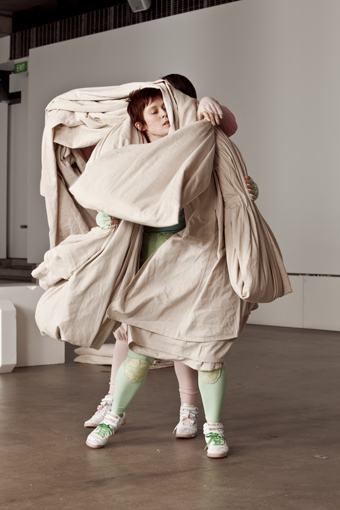 |
Alison and Bridget Currie, Three Ways to Hold photo courtesy the artists |
The impatient shuffling of the audience out of the way in Fold and the performer’s pernickety attention to the arrangement of objects as they’re bundled into a giant sack in Collect—as if it really matters how things are done—is seriocomic, an absurd rearranging deckchairs on the Titanic activity. Yet it’s the vacillation between these moments and states of attention that draws the audience’s notice to the things that really do matter in the work.
Three ways to hold creates and demands a certain type of attentiveness over the arc of its four performances. As each performance slides between attentive states and moments, so it asks for a dual kind of attention and noticing, a specific type of refined observation as it brings intangible processes under our consideration. Each performance is named after an action—Fold, Lift, Prop and Collect—and as each becomes a performative enquiry these concerns are played out in the interaction of volume, mass, weight and space and their transformation through the performers’ actions.
In creating a closed system where the base materials are introduced in the first performance and remain in the space til the last, the possibility of novelty is removed and our attention concentrated on these formal processes of activation, recombination and change in an evolving space of forces and relations.
This concern with the activation of space and transformation of forms is one pursued by both artists in their discrete practices as visual artist and dancer. Here, these individual preoccupations are brought together and refined in a piece that deftly conducts a subtle and intelligent dissection of intangible states and an exercise in extending our awareness.
Appearing sometimes coolly cerebral, at others, Three ways to hold reveals a gentle sense of the absurd. In pastel costumes complete with knee and elbow pads, the performers Alison and Bridget Currie become super heroes or terrestrial trapeze artists underscoring a sly humour and the sense of effort brought to bear in the constant reshaping of their small enclosed world.
Fold is an exercise in expansion and contraction of volume serendipitously aided by the size of the first night crowd. Barely able to be seen at first, the performers dart outside and back in carrying slabs, blocks and wedges of polystyrene. Taking canvas sheets from laundry trugs the performers almost impatiently shake these out and lay them on the floor, adjusting them with that fussy carefulness. Edges are butted together and folds smoothed out as the space is covered with the canvas’s enlarging surface. In a neat reciprocity of action as the canvas expands, the crowd contracts—forces in motion. Almost as soon as the floor is covered, the performers turn to transforming the flat canvas into compact stacks of folded cloth. Gathered and pleated, fabric rolled between fingers to bring corners into alignment, the sheets are folded. Switching between this over-carefulness and almost carelessness we are made aware of the intent and effect of each action as each dense slab of stuff hits the floor.
The four performances create a durational arc over as many weeks. Objects are left where they fall at the end of each performance, suspended in a state of flux so that time is stretched out, so that attention is slowed to a state where notice can be taken of the invisible forces at play.
In Lift, the heaps of folded cloth form a vestigial history of Fold. It begins with the performers urgently making constructions out of polystyrene blocks, running and lifting each block above their heads in a comic show of strength and ending with a frantic game of tag across the space, palms slapping the walls. As Alison dances and feints boxer-like around the space, Bridget shakes out each cloth, giving it a weightlifter’s clean and jerk before placing it around Alison’s neck like the proverbial boxer’s towel. There’s comical huffing as this continues, yet as the heap accumulates the weight is palpable and it becomes a question of resistance and endurance rather than force. Finally, Alison, with real effort, throws off the sheets so they lie disordered again on the gallery floor.
This play of force is directed inwards and slowed almost to inaction over the seven hours of Prop with the artists developing intense attention to the effect of every action as one performer takes responsibility for the other in the literal and constantly modified act of propping. Prop becomes an intense meditation on cause, effect and responsibility.
It’s into the remnants of Prop, the blocks and wedges of foam and heaped sheets that the audience for Collect gathers. There’s no seeming diminution of the audience and it appears that attention can be sustained over this arching space of time. Bridget and Alison collect up all the wedges, blocks and slabs, bundle away the sheets and stack them into their ever expanding bag. One holds the bag open while the other arranges and rearranges things, compacting them, fitting them together. As it grows weightier, they drag their sack around the space, lifting, folding, fitting.
Tying off the neck of this amorphous robbers’ swag neatly shuts down the performance and this careful system that has been created and investigated over time. Our attention has been sustained and now lingers on a system of things folded, lifted, transformed and put away.
Alison Currie’s show 42a, “an interactive space where the audience itself affects the display and presentation, purely by where they stand, where they move to and what they do,” has toured to Sydney and Brisbane and will be at Melbourne’s Fortyfive Downstairs October 12-23
Three ways to hold (fold, lift, prop and collect), created and performed by Alison Currie and Bridget Currie, costume design Gemma Stocks, SASA Gallery, Adelaide, Aug 11-Sept 3.
RealTime issue #99 Oct-Nov 2010 pg. 52
© Jemima Kemp; for permission to reproduce apply to [email protected]








 back
back